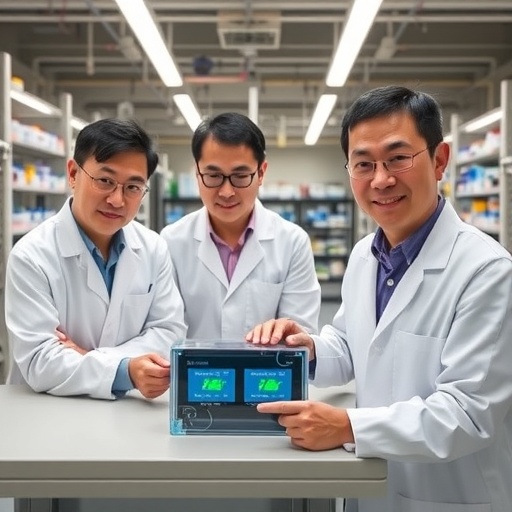In a groundbreaking advancement poised to reshape the future of energy storage, Professor Yoon Seok Jung and his research team at Yonsei University have unveiled an innovative fluoride-based solid electrolyte that enables all-solid-state lithium batteries (ASSBs) to safely operate beyond the long-standing 5-volt threshold. This pioneering work, which was published on October 3, 2025, in the prestigious journal Nature Energy, marks a paradigm shift in battery technology by overcoming the intrinsic limitations of existing electrolytes. The lithium chloride–lithium titanium fluoride compound, specifically LiCl–4Li₂TiF₆, emerges as a novel material platform with exceptional electrochemical stability coupled with high ionic conductivity, thereby facilitating ultra-high voltage operation without sacrificing performance.
For decades, the challenge of pushing the voltage limit in solid-state lithium batteries has remained a bottleneck in advancing battery energy density. Traditional solid electrolytes, predominately sulfide and oxide-based compounds, are notorious for their instability at voltages exceeding approximately 4 volts. This degradation leads to premature failure, capacity fade, and safety concerns. Addressing this critical issue, the Yonsei University team engineered a fluoride-based electrolyte that not only withstands voltages beyond 5 volts but also maintains a lithium-ion conductivity of 1.7 × 10⁻⁵ S/cm at 30°C—a remarkable figure considering the chemical robustness required at such high potentials. This conductivity level rivals, and in some instances surpasses, those found in existing solid electrolyte technologies.
The secret to this breakthrough lies in the unique chemical and structural properties of LiCl–4Li₂TiF₆. Fluoride ions confer excellent oxidative stability, which is essential for high-voltage battery operation, while the compound’s crystal lattice facilitates facile lithium-ion migration. This combination mitigates interfacial side reactions that commonly plague solid electrolytes in direct contact with high-voltage cathodes. In practical applications, the researchers applied this fluoride solid electrolyte as a protective coating on high-voltage spinel cathodes, such as lithium nickel manganese oxide (LiNi₀.₅Mn₁.₅O₄, LNMO). The result is an effective shielding layer that suppresses detrimental chemical interactions at the electrolyte-cathode interface, dramatically enhancing battery longevity and cycling stability.
Testing the battery performance under stringent conditions revealed a remarkable capacity retention of over 75% after 500 charge-discharge cycles—a durability metric rarely achieved in high-voltage solid-state systems. Moreover, the battery demonstrated an unprecedented areal capacity of 35.3 mAh/cm², a new benchmark in the realm of solid-state batteries. The system’s ability to sustain such high areal capacities while maintaining stable cycling performance underscores its suitability for practical applications, including electric vehicles and portable electronics. Importantly, the team validated the scalability of their innovation by constructing pouch-type battery cells, reflecting real-world manufacturing formats and further emphasizing the technology’s commercial viability.
Beyond electrically stabilizing high-voltage cathodes, this work presents a versatile platform for integrating cost-effective halide catholytes, such as zirconium-based compounds. The introduction of the fluoride-based shielding electrolyte facilitates compatibility between these inexpensive catholytes and solid-state battery architectures, subsequently driving down materials costs without compromising safety or performance. This dual advantage is poised to accelerate the adoption of solid-state batteries by mitigating two primary industry obstacles: the high production cost and material scarcity associated with conventional cathodes and electrolytes.
The implications of this research resonate far beyond immediate technological gains. Electric vehicles equipped with these advanced 5-volt solid-state batteries could experience significantly extended driving ranges, alleviating range anxiety and promoting broader EV adoption. Similarly, the energy storage sector stands to gain from battery systems capable of storing larger amounts of energy efficiently and reliably. Such advancements offer tangible progress toward integrating renewable energy sources seamlessly into existing grids, thereby supporting global decarbonization efforts and energy sustainability.
Professor Jung emphasizes that this breakthrough transcends the introduction of a single new material, instead articulating a foundational design principle for future battery innovation. The concept of employing a fluoride-based solid electrolyte as a protective interface introduces a new dimension to battery architecture, one that balances electrochemical performance with durability and safety. This holistic approach aligns with the increasing demand for robust energy storage solutions able to withstand diverse operating conditions over long lifespans.
From a materials science perspective, the fluoride electrolyte’s extraordinary oxidative stability arises from the strong ionic bonds within the fluorine lattice, imparting resilience against electrochemical decomposition. Concurrently, the lattice structure facilitates lithium-ion diffusion pathways that are essential for sustaining ionic conductivity at room temperature. The crystal-chemistry engineering behind LiCl–4Li₂TiF₆ represents a major stride forward in the synthesis of solid electrolytes that marry mechanical robustness with electrochemical function—a balance critical for commercial viability.
Equally significant is the battery’s demonstrated suppression of interfacial degradation phenomena, a notorious culprit behind failure in solid-state systems. The solid electrolyte’s ability to form a stable, chemically compatible interface prevents the formation of resistive layers and mechanical delamination, thus preserving efficient charge transport kinetics. These interfacial insights may guide future electrolyte design, applicable beyond lithium-based systems and into other next-generation battery chemistries.
The research team’s experimental study also serves as a blueprint for integrating solid electrolytes with existing cathode materials, signaling a potential shift in how battery components are engineered and assembled. Their work reminds the scientific community of the need to adopt multidisciplinary approaches—combining solid-state chemistry, electrochemical engineering, and materials processing—to unlock performance thresholds previously deemed unattainable.
Crucially, this work underscores the strategic advantage of leveraging abundant, low-cost raw materials, such as lithium chloride and titanium fluoride precursors, in constructing the solid electrolyte matrix. The affordability coupled with the scalability of synthesis methods bodes well for mass production, easing the transition from laboratory-scale demonstration to industrial application. This alignment with economic realities distinguishes the invention from other high-performance materials that face commercialization difficulties due to cost or scarcity.
Overall, the advance delivered by Professor Jung’s group represents a crucial leap toward the next chapter of sustainable battery technology. Integrating their fluoride-based electrolyte into commercial battery manufacturing may usher in energy storage systems that are safer, denser, and longer lasting, fitting seamlessly into electric transportation, grid storage, and portable electronics alike. The breakthrough stands as a testament to how fundamental materials innovation can catalyze transformative solutions for global energy challenges.
Subject of Research: Not applicable
Article Title: Five-volt-class high-capacity all-solid-state lithium batteries
News Publication Date: 3-Oct-2025
Web References: https://www.nature.com/articles/s41560-025-01865-y
References: DOI: 10.1038/s41560-025-01865-y
Image Credits: Yonsei University
Keywords
Energy storage, Batteries, Materials science, Nanotechnology, Renewable energy, Electric vehicles, Electrochemistry, Chemical engineering, Sustainability, Solid state chemistry
Tags: advanced battery materialsall-solid-state lithium batteriesbattery voltage limitselectrochemical stability in batteriesenergy storage technology breakthroughsfluoride-based solid electrolytesHigh Ionic Conductivity Materialshigh-voltage solid-state batterieslithium chloride lithium titanium fluoridelithium-ion conductivitysafety in battery technologyYonsei University battery research






